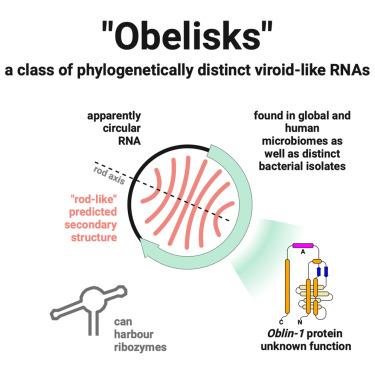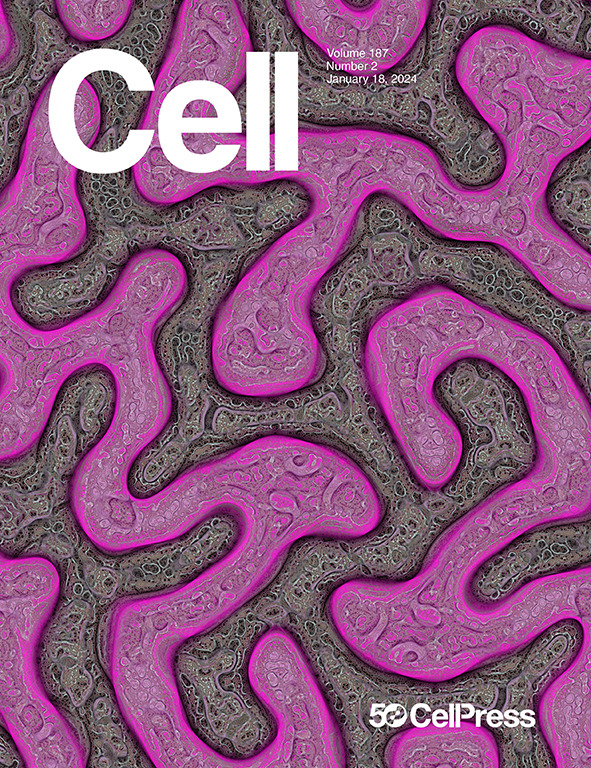Viroid-like colonists of human microbiomes
IF 45.5
1区 生物学
Q1 BIOCHEMISTRY & MOLECULAR BIOLOGY
引用次数: 0
Abstract
Here, we describe “obelisks,” a class of heritable RNA elements sharing several properties: (1) apparently circular RNA ∼1 kb genome assemblies, (2) predicted rod-like genome-wide secondary structures, and (3) open reading frames encoding a novel “Oblin” protein superfamily. A subset of obelisks includes a variant hammerhead self-cleaving ribozyme. Obelisks form their own phylogenetic group without detectable similarity to known biological agents. Surveying globally, we identified 29,959 distinct obelisks (clustered at 90% sequence identity) from diverse ecological niches. Obelisks are prevalent in human microbiomes, with detection in ∼7% (29/440) and ∼50% (17/32) of queried stool and oral metatranscriptomes, respectively. We establish Streptococcus sanguinis as a cellular host of a specific obelisk and find that this obelisk’s maintenance is not essential for bacterial growth. Our observations identify obelisks as a class of diverse RNAs of yet-to-be-determined impact that have colonized and gone unnoticed in human and global microbiomes.

人类微生物群落中的类病毒殖民者
在这里,我们描述了 "obelisks"--一类具有以下共同特性的遗传 RNA 元件:(1)明显的环状 RNA ∼ 1 kb 基因组组装;(2)预测的杆状全基因组二级结构;(3)编码新型 "Oblin "蛋白超家族的开放阅读框。方尖碑的一个子集包括一个变体锤头自裂解核糖酶。方尖碑形成了自己的系统发育群,与已知的生物制剂没有可检测到的相似性。我们在全球范围内进行了调查,从不同的生态位中发现了 29,959 种不同的同源物(序列相似度为 90%)。方尖碑在人类微生物组中非常普遍,在查询的粪便和口腔元转录组中,方尖碑的检出率分别为 7%(29/440)和 50%(17/32)。我们确定血链球菌是一种特定方尖碑的细胞宿主,并发现这种方尖碑的维持并非细菌生长所必需。我们的观察结果表明,方尖碑是一类影响尚待确定的多种 RNA,它们在人类和全球微生物组中定植,却不为人所注意。
本文章由计算机程序翻译,如有差异,请以英文原文为准。
求助全文
约1分钟内获得全文
求助全文
来源期刊

Cell
生物-生化与分子生物学
CiteScore
110.00
自引率
0.80%
发文量
396
审稿时长
2 months
期刊介绍:
Cells is an international, peer-reviewed, open access journal that focuses on cell biology, molecular biology, and biophysics. It is affiliated with several societies, including the Spanish Society for Biochemistry and Molecular Biology (SEBBM), Nordic Autophagy Society (NAS), Spanish Society of Hematology and Hemotherapy (SEHH), and Society for Regenerative Medicine (Russian Federation) (RPO).
The journal publishes research findings of significant importance in various areas of experimental biology, such as cell biology, molecular biology, neuroscience, immunology, virology, microbiology, cancer, human genetics, systems biology, signaling, and disease mechanisms and therapeutics. The primary criterion for considering papers is whether the results contribute to significant conceptual advances or raise thought-provoking questions and hypotheses related to interesting and important biological inquiries.
In addition to primary research articles presented in four formats, Cells also features review and opinion articles in its "leading edge" section, discussing recent research advancements and topics of interest to its wide readership.
 求助内容:
求助内容: 应助结果提醒方式:
应助结果提醒方式:


